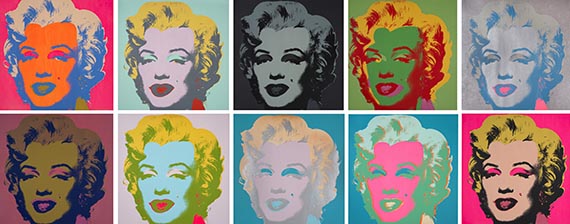Dictionary


Neo Pop
Pop Art also experienced a revival in Postmodernism, effects thereof can still be observed in present days. The respective term Neo Pop, which lacks a clear definition, was introduced in order to group those artists together who made works that had been influenced by Pop Art, but who did without a socio-political intentions.
Neo Pop, also known as Post Pop Art, had its heyday in the USA in the 1980s and also still a little in the 1990s, it was mostly referencing the oeuvre of Andy Warhol. Haim Steinbach (born in 1944) must be exemplarily mentioned in this context, however, the best known Neo Pop artist, without any doubt, is Jeff Koons (born in 1955). His works are entirely made by other people who follow his instructions, he himself has no share in the actual making, they borrow their subjects from everyday trivial culture and are thus quite similar to early works of Pop Art. Banal motifs that can almost be regarded as kitsch, are isolated and changed in size, material or context and are thus ennobled to art. Jeff Koons` concept of art seems to re-echo what Andy Warhol once said: "all is pretty". Jeff Koons put his art into the following words: "(...) the trivial can be our salvation, especially today. Banality is one of the most important means at our disposal. (...) It is a major temptation, as one has the unintended idea of being superior."
Besides Jeff Koons, the Japanese artist Takashi Murakami (born in 1962) with his comic-like works in strong colors, can be also be regarded as a Neo Pop artist. At present, the Hanover artist Christian Junghanns (born in 1970) explicitly uses the term Neo Pop for his ingenuous and merry works that call reminiscence of the comic-like simplification of Keith Haring.
Pop Art also experienced a revival in Postmodernism, effects thereof can still be observed in present days. The respective term Neo Pop, which lacks a clear definition, was introduced in order to group those artists together who made works that had been influenced by Pop Art, but who did without a socio-political intentions.
Neo Pop, also known as Post Pop Art, had its heyday in the USA in the 1980s and also still a little in the 1990s, it was mostly referencing the oeuvre of Andy Warhol. Haim Steinbach (born in 1944) must be exemplarily mentioned in this context, however, the best known Neo Pop artist, without any doubt, is Jeff Koons (born in 1955). His works are entirely made by other people who follow his instructions, he himself has no share in the actual making, they borrow their subjects from everyday trivial culture and are thus quite similar to early works of Pop Art. Banal motifs that can almost be regarded as kitsch, are isolated and changed in size, material or context and are thus ennobled to art. Jeff Koons` concept of art seems to re-echo what Andy Warhol once said: "all is pretty". Jeff Koons put his art into the following words: "(...) the trivial can be our salvation, especially today. Banality is one of the most important means at our disposal. (...) It is a major temptation, as one has the unintended idea of being superior."
Besides Jeff Koons, the Japanese artist Takashi Murakami (born in 1962) with his comic-like works in strong colors, can be also be regarded as a Neo Pop artist. At present, the Hanover artist Christian Junghanns (born in 1970) explicitly uses the term Neo Pop for his ingenuous and merry works that call reminiscence of the comic-like simplification of Keith Haring.
Offers
Headquarters
Joseph-Wild-Str. 18
81829 Munich
Phone: +49 89 55 244-0
Fax: +49 89 55 244-177
info@kettererkunst.de
Louisa von Saucken / Undine Schleifer
Holstenwall 5
20355 Hamburg
Phone: +49 40 37 49 61-0
Fax: +49 40 37 49 61-66
infohamburg@kettererkunst.de
Dr. Simone Wiechers / Nane Schlage
Fasanenstr. 70
10719 Berlin
Phone: +49 30 88 67 53-63
Fax: +49 30 88 67 56-43
infoberlin@kettererkunst.de
Cordula Lichtenberg
Gertrudenstraße 24-28
50667 Cologne
Phone: +49 221 510 908-15
infokoeln@kettererkunst.de
Hessen
Rhineland-Palatinate
Miriam Heß
Phone: +49 62 21 58 80-038
Fax: +49 62 21 58 80-595
infoheidelberg@kettererkunst.de
We will inform you in time.




